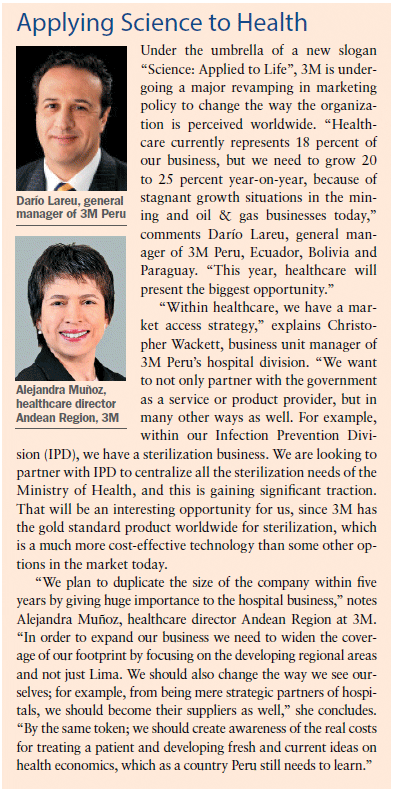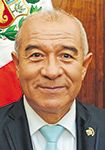Country Report: Peru
Although questions around sustainability still cloud Peru’s transition to a modern healthcare system, there is no doubt that the country’s economic resurgence in recent years is having a positive impact on Peru’s pharmaceutical infrastructure.
This sponsored supplement was produced by Focus Reports. Project Director: Cameron Rochette
Project Coordinator: Gabriela Córdova, Alina Cotfasa Project Publisher: Mariuca Georgescu
To read exclusive interviews, visit www.pharmaboardroom.com
Since 1995, Peru's pharma market has grown fivefold, and today is worth USD 2 billion. During this period, Peru's economy has emerged from the shadows: with an average annual growth rate of five percent during the period, even managing eight percent during the global financial crisis. But how exactly did the country come to perform so well, especially considering the economic volatility experienced by many of its neighbors over the same period? And what does this mean for the pharma industry?

(PHOTO CREDITS: CAMERON ROCHETTE)
Aldo Defilippi, executive director of AmCham Peru, says that since the 1990s the country has enjoyed a relatively steady government administration, which has contributed to not only strong economic growth but also a much larger middle-class population. "The stability of Peru's fiscal accounts, currency and laws for the last 25 years has created growth, reduced poverty, increased exports and has developed the country," he notes. "These characteristics are distinctively different compared to previous decades in Peru that had high inflation and fiscal deficit."

Aldo Defilippi, executive director, AmCham Peru
Furthermore, the establishment of over thirty bilateral investment treaties with nations across the globe has led Peru to a significantly more competitive position worldwide for investment; between 2002 and 2012, foreign direct investment (FDI) increased from USD 3 million to USD 12 million. "The openness of Peru to trade has encouraged the country to concentrate on those products that are best produced here and to import products of low cost and high quality," remarks Defilippi.

Applying Science to Health
UNMASKING THE UMBRA
Many multinational companies with a long-standing presence in Peru used to have factories in the country; since the 1990s all of these companies have closed their facilities as part of a consolidation process to other larger countries in the region like Mexico, Brazil or Colombia. Nevertheless, the fivefold growth of Peru's market between 1995 and 2010 to a market today worth USD 2 billion represents a sizeable opportunity for pharmaceutical companies with a South American presence.

Guillermo Browne, director general, MSD Peru
This growth took a slight nosedive in 2014, when the market experienced a cleansing of sorts. "Wholesalers and pharmacy chains found themselves with high inventories, and they needed to find some logistical efficiency in their own distribution systems," notes Guillermo Browne, director general of MSD Peru, which had to make adjustments as did most research-based companies in the country. "In 2014 the market decreased around two percent in volume and six percent in its value in US dollars. In that kind of environment I had to make some immediate structural changes. Last year was ultimately successful but more because of institutional sales rather than retail."

Javier Castro, managing director, Boehringer Ingelheim Peru
"Historically, pharmaceutical companies used to aggressively push merchandising through every channel possible," says Boehringer Ingelheim Peru's managing director Javier Castro. "Big chains started to reduce inventories, resulting in a significant decrease in many companies' retail sales last year. The country's commercial dynamics have strengthened sales channels to be more efficient, especially in managing inventory approaches."
A FREE FOR ALL
Peru's constitution does not permit price control, essentially creating a free market scenario that poses problems for major international pharmaceutical companies that generally offer higher-priced products. "Research-based companies do not sell to the government on public bids," says Augusto Rey de la Cuba, executive director of Asociación Nacional de Laboratorios Farmacéuticos de Perú (ALAFARPE), the association for research-based pharmaceutical companies operating in the country. "They only do direct sales because of the price. ALAFARPE's member companies simply cannot compete with local prices or the prices of Chinese or Indian companies present in Peru. There is a system in Peru for corporate bids in which the Ministry of Health, EsSalud, and the national army buy medicines together annually in an attempt to improve prices."

Augusto Rey de la Cuba, executive director, ALAFARPE
"Free pricing is not the perfect solution in an unstructured market, and people do not know what the real price is versus what they should pay," adds José Antonio González, general manager of Roemmers Peru. "I too would like to have nice prices and a big market, but I have a small market."
Furthermore, many pharmaceutical companies face complex challenges when it comes to Peru's regulatory system. Until 2009 for example, the legal time for approving new drugs, including biologics, was seven days; in 2015 approvals can take up to three years. For years, the system was largely unregulated, but serious efforts to alleviate this regulatory conundrum in recent years have been met with varying degrees of success.
REGULATORY REVOLUTION
"The implementation of Law 29459 (also known as the Law of Pharmaceutical Products, Medical Devices and Sanitary Products) in 2009 focused on transforming an unregulated market into a more secure, quality-based healthcare model," notes Cesar Amaro, director general of Dirección General de Medicamentos, Insumos y Drogas (DIGEMID), Peru's regulatory agency. "This new law focuses on the regulation of biotechnological and biosimilar products which represent an important area for development. This law also pays attention to the interchangeability between brand generics and patent protected drugs." As such, the idea was for this Law to set new standards on approvals as well as ensuring better quality, efficacy and safety of health-related products. This has been particularly important in recent years as the government has been looking to purchase biosimilars, which many in both the private and public sectors will cut expenditure costs significantly.

Cesar Amaro, director general, DIGEMID
"Patients look for affordable medicine, and so does the government," says Akhilesh Vijay, general manager of Accord Healthcare Peru. "But this will not add long-term value to patient treatment. When biosimilars are newly registered, we need to produce safety and efficacy studies. As a responsible generic player Accord carries all the requisite studies. The current scenario demands DIGEMID to reach a consensus on fast tracking registration of biosimilars on the availability of such studies. Bioequivalence studies are not a requirement in Peru at the moment but they should be, and Accord can provide these as well."
"Our strategy is to establish more therapeutic segments and grow with our biosimilar portfolio in this market," Vijay mentions. "Biosimilars represent a significant Business in Peruvian institutions. Only certain companies with sophisticated technology can offer biosimilars. Adoption of stricter norms by DIGEMID including GMP inspections will slowly wash off inferior products from the market, and pave way for high end generic products. Competition will boil down to few players, and thereby only affordable and quality products will be made available to the patient community."

Akhilesh Vijay, general manager, Accord Healthcare
CAN PERU "INNOVATE"?
Oscar Seclen, commercial manager of Janssen Peru and president of ALAFARPE, also points out that the development of new molecules in the country is becoming more commonplace among pharmaceutical companies, although there is still much work to be done. "New laws are instigating clinical research in our country," he remarks. "Starting from the public domain, there is a lot of recognition for innovation; still, the investment levels are low if we compare them to countries abroad. This is where a huge opportunity appears just before our eyes and the private sector becomes necessary. As a guild, ALAFARPE acts as a catalyst for the private sector to reach its full capacity by providing recognition for what we consider outstanding research and innovation. The authorities have a very important role in all of this; they are the ones that need to set the right conditions and stage if we truly want to become an innovating country."

Esperanza: Hope for Cancer
THE BUILDING BLOCKS OF HEALTHCARE
Peru's healthcare system was largely underdeveloped for many years; but the country's newfound fortune of recent years has allowed for a significant overhaul and reform of the system.
However, the road to a comprehensive and universal system is rocky. Peruvian Congressman Gustavo Rondón, secretary for the Committee on Health and Population, notes that the budget for healthcare in Peru is one of the lowest in Latin America. "As such, we must prioritize investment in this area efficiently. Peru often gets ahead of itself with technological developments or innovation, while we still need to implement the basics. We become idealists; we want the latest technology, but in reality that will only reach a few people. We should be more practical than theoretical by putting norms into practice and allocating more personnel and equipment."

Gustavo Rondón, secretary for the Committee on Health and Population, Congress of Peru
One of the key goals of Peru's Ministry of Health is to now provide universal health coverage for all Peruvians by 2021. Between 2011 and today, the number of affiliates associated with Seguro Integral de Salud (SIS), the public health insurance agency run by the Ministry of Health that provides access to basic health services to unemployed Peruvians and those unable to pay for social security or private insurance, has increased from 12 million to 15 million, nearly half of Peru's entire population, in part due to increased funding for the agency. With 25 percent of the population without any access to social protection today, there is still a great deal of work to be done to ensure that universal coverage is reached.
Leading the charge in this endeavor is Pedro Grillo, chief of SIS. He has an immense weight on his shoulders to not only ensure universal coverage but to guarantee that the system is sustainable to maintain this coverage by improving the infrastructure, services and security of Peru's public health institutions. "To introduce the process of universal insurance reform in Peru, we must revise our benefit plans to suit the needs of our policyholders," Grillo stresses. "We have introduced a performance-based model exchange with other public institutions such as public hospitals and regional health facilities. We also exchange services with EsSalud (Peru's social security) and we purchase services to private providers of health services, in order to grow our supply base for our members."

Pedro Grillo Rojas, chief, SIS
Moreover, the Ministry of Health announced a USD 3.5 billion investment in infrastructure projects in November 2014, aimed at revamping old hospitals with crumbling infrastructure and building up to 50 new hospitals within five years. This investment has received mix opinions among various stakeholders, but certainly provides good opportunities for the private sector.
"We are now starting to see brand new public health centers pop up across the country, in places like Piura, Chiclayo, Tumbes, Cuzco, Arequipa or Tacna," states Carolina López-Torres, general manager of Hospira Peru. "Consequently, I think we can compete with other Latin American countries' hospitals. This is great news for us and for industry; now is the moment to invest and support the sector. Contracts with foreign companies with more experience can be very beneficial. In my position, it is critical to be the first to get our type of products to these hospitals."

Carolina López-Torres, general manager, Hospira Peru
OUT OF THE SHADOWS
While Peru's future still remains unclear as the mist that shrouds its majestic Machu Picchu in mystery, it cannot be denied that the country's economic improvement in recent years is having a positive impact on healthcare infrastructure throughout. Time will tell if Peru has what it takes to ensure a sustainable transition to a modern healthcare system.
